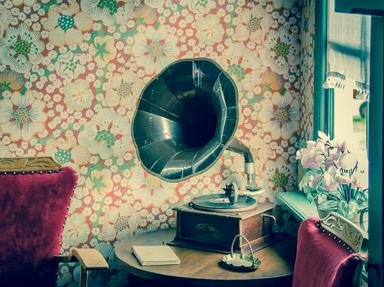Quiz Answer Key and Fun Facts
1. Betty was working in the Aeolian Hall, Manhattan NY when George Gershwin performed "Rhapsody in Blue" for the first time. Oh, she did get the shivers when she heard the first notes coming from Paul Whiteman's Orchestra. But did she have some lyrics to remember, or was it an instrumental?
2. It is the end of 1925 and Betty is asked by a good friend about a new song. As he does not know the title, he sings as best as he can remember:
"Well let me tell you well no chick made
Could be the same as....as..."
Betty starts singing:
3. It is 1927. Betty had just celebrated her birthday party. She got several records with the same song, done by different artists. Her mistake. She should have told them, which version she liked the most. She preferred The Knickerbockers' version. And now she would be going to the cinema to see her first talkie. She had heard Al Jolson would be singing that song, too. Which Irving Berlin composition was a big hit that year?
4. Still in 1927 New York Flapper Betty asked a country bred friend, what a Whippoorwill is? She just heard about a whippoorwill call at the beginning of a song. Which song was it, can you guess?
5. In 1929 Betty had come in a bit of money and invested in the stock-market. After the wall street crash, she nearly lost everything. Her friend left her, too. Only her gramophone gave her some comfort.
Which Ethel Waters song of that year dealt with a question she often asked herself?
6. In 1930, Ted Lewis & His Band made a song about an "Easy Rider". The song was named like a colorful animal. Take a sporting guess, the picture might help.
7. It's still 1930.
Betty's friend celebrates his birthday and wants a Jimmie Rodgers record with a Tennessee Hustler and a policeman. Which record will Betty wrap up and give as a present?
8. It is 1935 and Betty is feeling sentimental. She just feels like Bing Crosby in his great hit, watching what?
9. Later in her life, Betty, being now a respected old lady, skipped through the records of her grandchild. She was surprised about a song named "Smoke on the Water". Oh no, not because she was interested in that style. No, because she remembered the band's name (nothing smoky!) from an old record of the 30s. Did this band get its name from that song of her memory?
10. 1939, the end of a turbulent decade. Betty put a Glenn Miller song on the gramophone. The original song dates back to 1869 and what liquid was in that little brown jug?
Source: Author
heidi66
This quiz was reviewed by FunTrivia editor
1nn1 before going online.
Any errors found in FunTrivia content are routinely corrected through our feedback system.

